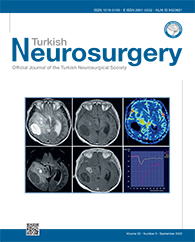MATERIAL and METHODS: Fifty-six patients and 142 vertebrae that underwent autologous bone graft insertion technique between 2009 and 2018 were analysed retrospectively. Demographic data, comorbidities, and perioperative findings of patients were recorded. The midline anteroposterior (AP) diameter was measured at the bone graft insertion levels, and fusion formation was evaluated with computed tomography (CT) and dynamic X-Ray images. Pain scores were assessed preoperatively with the visual analogue scale (VAS) for both legs and Oswestry Disability Index (ODI) for overall life quality. Scores were re-evaluated on 1st day, at 3rd, and 12th months, postoperatively.
RESULTS: Degenerative spinal stenosis was present in 56 patients who underwent autologous bone graft insertion technique. It was found that the diameter of the spinal canal increased by 37% in CT measurements. In postoperative radiological followups, fusion developed in 49 (87.5%) patients. There was a statistically significant decrease in both VAS and ODI scores in the postoperative period when compared to the preoperative evaluations.
CONCLUSION: Bone graft insertion technique supports posterior fusion and protects against dural injuries during revision surgery by creating a barrier over the dura. The prevention of epidural fibrosis formation reduces the symptoms of the postlaminectomy syndrome. The fact that this technique does not require fixation material. Therefore, it reduces expenditure and eliminates the risk of complications related to synthetic materials.
Keywords : Spinal fusion, Stenosis, Laminectomy, Autologous bone graft




